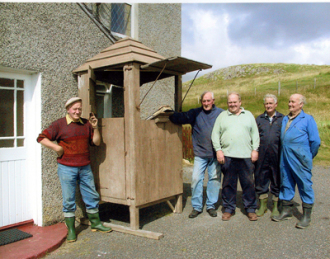Calum Nicolson (Calum Beag)
AIG AN OBAIR – From an article in Tional April 1994
When I left school in Lemreway in 1934, I got a job as a postman, delivering letters to thirty-two crofts in Lemreway, thirteen crofts in Orinsay and four crofts in Stiomreway. This was a departure from the accepted custom as boys usually took a job in a fishing boat on leaving school. There were plenty of opportunities, as there were nine boats fishing our of Lemreway at the time, all requiring a crew of five adults and a boy. The boats left Lemreway on a Monday and were based in Stornoway until they returned the following Saturday morning.
Delivering the mail to Stiomreway was quite an arduous task. It was over two miles from Orinsay over rough moorland and around lochs. In those days, most of the mail comprised of catalogues and parcels from J. D. Williams and similar mail order firms. The catalogues were often ordered for the girls in the Village by boys under pet names and I became quite expert at spotting the fakes and most of them found a resting place at the bottom of the loch about a mile out of Orinsay. Stiomreway was eventually abandoned in 1941.
This occupation was only available when the regular postman was on holiday or ill. Between times, I found work at one of the road building projects going on at the time and soon felt I was well on the way to becoming a millionaire. With our newly earned wealth, five of us ordered brand new bicycles from – wait for it – J. D. Williams, of course. They cost £5 each and we paid them up at ten shillings per week or 50p in to-day’s currency. They were called ‘Flights’ and we were very proud of them. We collected a few cuts and bruises before we mastered them, but we soon got the hang of them and felt very proud of ourselves riding to Church at Gravir on Sunday, scattering the rest of the congregation as we sped by on the four-mile journey. I suppose we were as popular as the Red Arrows are to-day.
